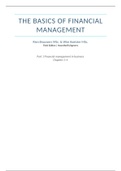Samenvatting
Basics of Financial Management | Summary | MAN4
Summary of: Basics of Financial Management I received a 9.6 for my exam by learning this summary! Consists of Part 1: Chapters 1-4 1 Businesses and their role in the economy 2 Financial management disciplines and positions 3 Financial statements 4 Business plan Breda University of Applied Scienc...
[Meer zien]









